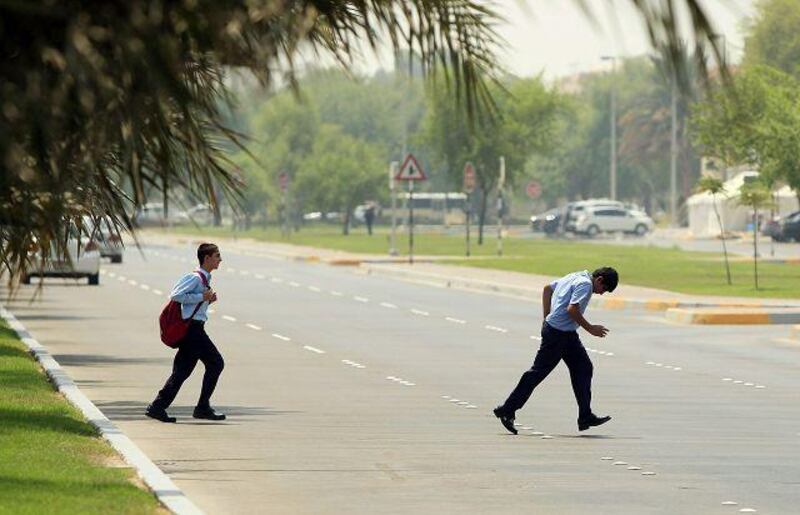Groups of children darted across the busy, six-lane road while some chased each other around trees on the central reservation as motorists passing at speeds as high as 80kph nervously sounded their horns.
It was just after 1pm and classes had finished for the day at the Sheikh Khalifa bin Zayed Arab-Pakistan School in the capital, unleashing a flood of youthful energy into the neighbourhood. Muhammad Munir, the head teacher, agreed that traffic around the school raised safety concerns. "Walking across the road, that is the biggest problem," he said. "I don't know what should be done. "I have been talking to the boys and girls but they are youth, they don't understand. My main concern is that people should cross from the proper places."
Farad Hijad, a 17-year-old Pakistani student at the school, said he felt the area was unsafe. "It is very difficult because this is a main road, it leads to a highway," he said. "They should build flyovers like in Dubai for the pedestrians." With safety regulations for school zones varying from emirate to emirate and measures differing in some cases from school to school, some principals and pupils are calling for stricter, uniform rules for motorists near schools.
Others, particularly in Dubai, say adequate traffic calming measures are already in place. One particular problem in Abu Dhabi is that its villa schools are tucked away on residential streets, and often not clearly marked for motorists. Many of them do not have people to help children cross busy streets. According to Abu Dhabi Police figures, 1,112 children were killed after being struck by a vehicle between 2001 and 2007. The statistics do not include details on how many were walking to or from school.
Authorities in the emirate say they are addressing the safety issues. A spokesman for the Abu Dhabi Education Council said it was working with the municipality, recommending ways to "improve traffic flow and road safety in areas surrounding our existing schools". Abu Dhabi Police said that after Eid it would be launching a back-to-school road safety campaign. Tom Matthews, projects director at Taaleem, the second-largest private school operator in the country, said traffic impact studies must be conducted before Dubai or Abu Dhabi municipalities approved new schools.
However, some principals thought more could be done to improve safety around existing schools. Mohamad Haris, principal at Al Noor Indian Islamic School in Abu Dhabi, said there were no road signs in the vicinity to warn motorists that they were entering a school zone. "We are facing so many troubles here because of traffic," he added. "Drivers are parking their cars in the middle of the road. "We have school buses and so many parents are coming with vehicles, it makes the chances of accidents high."
Cars were often left in the middle of the street for days at a time, making it difficult for school buses to get around. "We are very worried about that," he said, adding that speeding was sometimes a problem as well. "We want small humps. If the municipality would put those down it would be very good for us." Inbanathan C, principal of the Sunrise Indian School in Abu Dhabi, said he had similar problems.
"The parents can't park and walk their kids in." While Clive Pierrepont, director of communications and marketing at Taaleem, said none of its seven schools had any major problems, he pointed to other schools that, he said, "have been built in areas where it is patently obvious that safety has not been a concern in their sitting". The Oud Metha neighbourhood in Dubai was one example, he said. Traffic-calming measures in the capital appear to differ from one school zone to the next. On 25th Street near Salam Street, near a side street containing several schools, there is a prominent sign saying "school" in both Arabic and English, and a pictogram of an adult and child crossing the road.
There are also flashing lights near the pedestrian crossing and rumble strips before the crossing point. However, many vehicles still seem to be travelling at or above the speed limit of 60kph in that area. Down the road at Abu Dhabi Indian School, which is on 23rd Street, also near Salam Street, the only indication for approaching motorists that a school is in the area is a small white sign. The zebra-striped pedestrian crossing in front of the school has faded and is almost invisible.
By contrast, Neha Palshelkaa, whose two children attend Our Own English High School in Dubai, felt reassured by the road safety measures around the school. "I feel that my children are very safe here," she said. "First off, the security will absolutely not allow the children out of the gates without supervision. Secondly, the road bumps make sure that cars drive past slowly, so I don't worry at all."
Thanks to roundabouts, intersections, speed bumps, and congestion, cars never did much more than 30kph on the main road during school drop-off and pickup times. "In the UK, they are now putting models of children outside of schools in their uniforms," said Peter Daly, head teacher at the Dubai English Speaking College. "I think there is some very irresponsible driving around school areas." * The National






